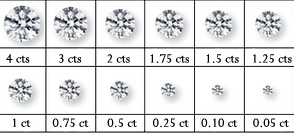If you are one of those people who believe that carats define the size of the diamond, it's our duty to tell you: You are wrong! Mostly everyone misunderstand the concept of the weight thinking that it is all about the size of the stone when it really isn't.

The carat (cts) is the metric used to measure diamonds and gems. Weather it is measured carat by carat or point by point (1.00 cts = 100 points), as some gemologists do for a more exact number, the weight of the stone does not reflects its size. We can say that a total of 200 milligrams is the weight that defines 1 carat, approximately the total weight of a paperclip, but what we can't say is that a diamond of 1.00 cts is bigger in size than one of 0.98 cts. In simple words: carats are for weight, NOT for size.
Carat, the word that comes from "carob" (a seed), used by diamond traders to measure these stones a long time ago; its the principal factor that sets the price of these beautiful brilliants. Along with the rest of the 4Cs, carat by carat the price of the stone increases due to the difficulty of finding bigger diamonds well graded on the other aspects. This means that two diamonds with the same number of carats will hardly cost the same, it changes according to each characteristic like the cut, color, clarity and other variables; weight is just one of them.
Sometimes, even when you compare two 1.00 cts diamonds side by side, you can notice that one is bigger than the other, this is because of the millimeters of the table. It is also possible to have a bigger diamond weighing less than another one heavier looking smaller. (For example a .98 cts diamond looking bigger than a 1.00 cts brilliant). If the diamond has a deep cut then the brilliant will appear smaller. In the following chart you can find an example of the visual difference between the most common weights:

Most of the times, you can easily perceive a difference in size among each .25 points between one diamond and another. The average measurements of the most popular round diamonds are among the ones described in the following chart:
| Carats | Measurement (Diameter) |
| .25 cts | 4.1 mm |
| .50 cts | 5.0 mm |
| 1.00 cts | 6.4 mm |
| 1.50 cts | 7.3 mm |
| 2.00 cts | 8.1 mm |
| 2.50 cts | 8.5 mm |
| 3.00 cts | 9.4 mm |
There are three things you must consider when you decide over your diamonds weight: your budget, the size of her hand and the design of the ring.
- If you are taking care of your budget, take a look into brilliants under full carat weight, you can find a big difference in price between a 1.00 cts diamond and a .90 cts one. They can even look the same when it comes to size but that minimum change in weight can make a big difference in the final price.
- If you have no idea about what weight will be the perfect for her, remember that it is not the same to see a 1.00 cts diamond in a hand with a finger size 3 than with a finger size 7.
- If you already know the design of the ring you want for her keep in mind that some mountings are specially made for some diamonds and specific measures, otherwise the ring can damage the appearance of the diamond.
Remember that also each shape has its own benefits, the marquise, oval, pear and emerald can seem to be bigger since their shape is elongated, but it always comes out to depend on a matter of taste (To learn more about the diamond shapes click here). You can weather prioritize the diamond weight and manage the rest of the 4Cs, or if you are looking forward to get a better color, clarity or cut you can look for a reasonable weight to reach to your ideal diamond.
If you have any questions regarding the carat weight contact our experts! We can help you by answering your doubts, guiding you with the best tips and looking for your ideal diamond!
Was this article useful to you? Let us know! Write down your comments, thoughts, and questions, we'll be glad to hear your opinion!
 The best quality at the best price
The best quality at the best price 